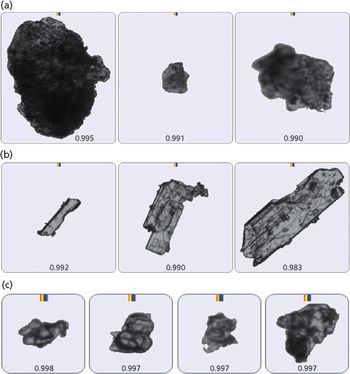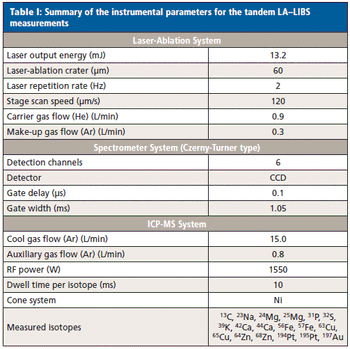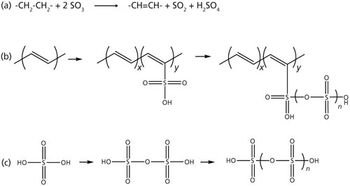
This SERS method is rapid, accurate, nondestructive, and easy

This SERS method is rapid, accurate, nondestructive, and easy

This study presents a novel, time-efficient, and cost-effective procedure for determining the percentage of oil content in binary mixtures of peanut and canola oils.

This article introduces a new IR technique, microfluidic modulation spectroscopy (MMS), that is designed to address the needs in biotherapeutics, and presents data from measurements of commercially available proteins.

The establishment of quantitative models based on the near-infrared (NIR) spectroscopic analysis of plant samples plays an important role in improving both the scope of the models and the accuracy of prediction. This technique could provide a new method for tobacco quality management and provide a new discriminant method for other agricultural products.

Single-cell ICP-MS can accurately quantify the metal concentrations within individual cells, providing new information about the mean metal content and the variation within a cell population. This method is shown to be a vital tool for assessing the specific uptake of metals by ovarian cancer cells and fresh water algae.

Although recent steel coating methods have demonstrated improvements in corrosion resistance, they can prove expensive and complicated. In this study, XPS analysis was used to evaluate the corrosion resistance of steel treated with an alternative technique.

FT-NIR spectroscopy can be used to overcome a range of challenges in raw material identification while also meeting the stringent requirements of regulated environments.

The combination of microwave sample preparation and ICP-OES is examined to meet the challenges of measuring a suite of heavy metals in a wide range of electronic components for RoHS/WEEE compliance.

John M. Cottle, the winner of Spectroscopy’s 2018 Emerging Leader in Atomic Spectroscopy Award, is a leader in the development of novel laser-ablation inductively coupled plasma–mass spectrometry measurements and their application to tectonic questions in convergent orogens. His three breakthrough measurement methods using LA-ICP-MS for geochemical data collection are breaking new ground in Earth science.

Can morphologically directed Raman spectroscopy obtain more discriminatory information from forensic samples than current tools?

This study reveals the ability of Raman spectroscopy to identify some forensically relevant body fluids, both

In the last decade, numerous SERS substrates have been developed, but it is difficult to compare and validate their plasmonic performance. In this overview, the authors discuss the three physical parameters of any new SERS platform that must be measured-morphological characterization, optical scattering (far-field response), and near-field properties-and future prospects for the development of new SERS platforms.

This method demonstrates that ICP-OES is a suitable alternative to ICP-MS for the determination of rare earth elements in geological and agricultural samples

This method demonstrates the excellent suitability of a multimodal approach that combines LA-ICP-MS with LIBS for the analysis of tumor samples, particularly when the standalone techniques cannot detect all the elements of interest.

The apparent reaction kinetics between SO3 and polyethylene are investigated in various halogenated solvents using in situ Raman spectroscopy with an immersion Raman probe, demonstrating the power of in situ Raman spectroscopy to monitor hazardous reactions.

Antacids present a unique set of analytical challenges for ICP-MS. These challenges can be overcome with optimized sample preparation and instrumental analytical conditions.

This review assesses the use of WD-XRF spectrometry for the analysis of major and trace levels of heavy and toxic minerals in biological specimens related to agricultural crops and human diseases.

This method, for the evaluation of the enantiomeric purity of particular phosphonate derivatives, offers advantages in terms of cost, simplicity, and measurement speed.

A straightforward numerical approach to estimate the performance of a spatial filter in Raman backscattering spectroscopy has been developed. This approach enabled the authors to determine an optimal hole diameter that balances spatial resolution and signal intensity.

Excited state dynamics provides an intrinsic molecular contrast of samples examined. These dynamics can be monitored by pump probe spectroscopy which measures the change in transmission of a probe beam induced by a pump beam. With superior detection sensitivity, chemical specificity and spatial-temporal resolution, pump probe microscopy is an emerging tool for functional imaging of non-fluorescent chromophores and nanomaterials. This article reviews the basic principle, instrumentation strategy, data analysis methods, and applications of pump probe microscopy. A brief outlook is provided.

This article reviews recent advances in the application of Transmission Raman Spectroscopy (TRS) to pharmaceutical analysis. The TRS technique overcomes subsampling limitations of conventional Raman spectroscopy and enables rapid non-invasive volumetric analysis of intact pharmaceutical tablets and capsules in a quantitative manner with relevance to quality and process control applications. Although only recently introduced to this area its uptake and the breadth of applications are rapidly growing with regulatory approvals for use of this technology in quality control of manufactured pharmaceutical products recently being granted.

Portable instrumentation for Raman spectroscopy has rapidly evolved over the last decade, where sample testing that once occurred in the laboratory is now executed in the field (e.g. warehouse). Portable Raman spectroscopy is a powerful technique for the rapid identification of diversely sourced raw materials used in pharmaceutical processing. In addition to portability; reduced cost, rapid data acquisition and ease of use make this powerful technique attractive and accessible to both expert spectroscopists and non-specialists. In most cases, the method development can be easily accomplished in the laboratory after which the instrument and methods are transferred to field for sample analysis or warehouse areas for inspection of incoming raw material. Qualitative Raman methods for identification of raw materials typically utilize spectral libraries for sample to standard comparison. When developing Raman spectral libraries for raw material identification, great care is required when considering critical factors (e.g. instrument type, Raman capability, container type, container interference, background interference, material variability) that can potentially influence the identity of the material. This paper discusses portable Raman techniques and approaches for raw material identification, as well as key considerations for developing and validating Raman spectral libraries.

This article reviews the state-of-the-art of far-ultraviolet (FUV) spectroscopy of solid and liquid phases. FUV spectroscopy is rich in information about electronic structure and transitions of a molecule, but this region has been employed to investigate mainly for the electronic states and structure of gas molecules because the absorptivity is very high in the FUV region. To overcome this difficulty we have developed a totally new FUV spectrometer based on the attenuated total reflection (ATR) technique. ATR-FUV spectroscopy has paved a new avenue for condensed matter FUV spectroscopy. This article demonstrates that FUV holds considerable promise not only in basic science such as studies of electronic structure of molecules, hydrogen bonding, hydration, and adsorption of water and aqueous solutions, but also practical applications, such as on-line analysis, geochemical and environmental analyis, semiconductor research and surface analysis.

The accurate determination of protein structure is integral to the medical and pharmaceutical communities’ ability to understand disease, and develop drugs. Current techniques (CD, IR, Raman) for protein structure prediction provide results that can be poorly resolved, while high resolution techniques (NMR, X-ray crystallography) can be both costly and time-consuming. This work proposes the use of drop coat deposition confocal Raman spectroscopy (DCDCR), coupled with peak fitting of the Amide I spectral region (1620–1720 cm-1) for the accurate determination of protein secondary structure. Studies conducted on BSA and ovalbumin show that the predictions of secondary structure content within 1% of representative crystal structure data is possible for model proteins. The results clearly demonstrate that DCDCR has the potential to be effectively used to obtain accurate secondary structure distributions for proteins.

The development of novel, nondestructive technologies for rapid analysis of evidence discovered at crime scenes is pertinent to our criminal justice system to solve the millions of violent crimes that occur each year. Without a witness, establishing the precise timeline of a crime is difficult. Therefore, technologies based on sensitive, nondestructive techniques are needed to evaluate evidence and create such a timeline. We propose the use of Raman spectroscopy to analyze the age of bloodstains for potential use as a forensics tool. Previous studies have revealed Raman spectroscopy is sensitive to changes in blood analyte concentration and different oxidative states of hemoglobin. Raman spectroscopy could allow for rapid comparison of spectra from blood stains of unknown age to spectra of known age with high temporal accuracy. Though further investigation into other substrates and biochemical components should be performed, our study reveals Raman spectroscopy has the potential to accurately and nondestructively determine the age of a bloodstain for use in criminal investigations.